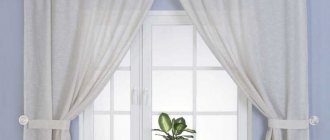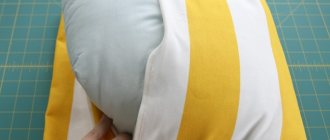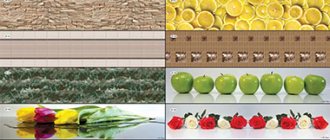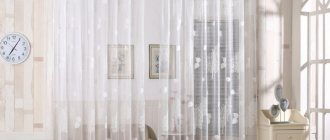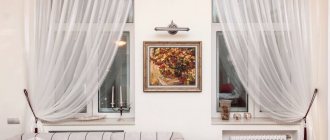When decorating a window opening, the correct choice of tulle can play an important role. It is not only one of the decorative elements, but also protects the room from bright sunlight, dust and various living creatures, as well as fading of furniture, without reducing the level of lighting in the room. But, despite the fact that the choice of ready-made tulles today is quite large, sometimes it is not possible to find an option suitable for all parameters. And it is at this moment that the question arises of how to sew tulle yourself, while knowing exactly what the finished product should be like.
Types of fabric for tulle
To choose a fabric, you need to understand how different types differ from each other. They differ primarily by production method: smooth or patterned; by color and by the raw materials used.
Curtains for the room
Depending on the type of yarn and manufacturing variations, there are the following types of fabric:
- Organza. Transparent, lightweight, but dense and rigid material that holds its shape well. It is made from polyester, but there are expensive models made from silk or viscose. Poor air permeability.
- Net. Thick fabric with holes that allow light to pass through easily. Typically made from synthetic fibers. Great for the kitchen.
- Muslin. Lightweight, soft fabric made from fine threads. It allows air to pass through well, is easy to wash and dries quickly. Silk, cotton or wool are used for production.
- Veil. A thin translucent matte fabric that is most often used to sew curtains. It is made from cotton, silk, wool or linen. Lightweight, holds its shape well, although it collects dust a lot, gets dirty and fades. Perfect for the hall.
- Gas. This type of fabric has transparent, thin and light material. Usually made of silk, but sometimes they are made of synthetics.
Types of Fabric
All of these materials can make excellent curtains. You just have to figure out how to sew beautiful tulle on the windows.
Secrets of a home seamstress
Before processing tulle at home, the fabric must be washed and ironed. A great-looking and straight fabric will be easy and pleasant to hem. It is very comfortable to use the “American” seam at home; it is quite light and at the same time virtually invisible. To sew decorated curtains, you must first choose a strong material that is not prone to fraying on the sides. Then the curtains will definitely not tear and will last a long time.
If you need to shorten industrial curtains, you should not trim the edges, otherwise the threads may fray and the work will become noticeably more complicated. You just need to carefully bend the fabric to the appropriate length, then there will be no problems with sewing. It is better to sew by hand than on a machine, since an incorrectly configured machine can only spoil the piquant material.
The correctness of the cut is of great importance, therefore it is best to use ready-made patterns from the Internet or specialist literature. There you can also read about how to properly hem curtains and tulle .
When working at home with particularly demanding fabrics, you need to do cutting and sewing at a level, well-lit table. Any dents or indentations on the surface of the work table can prevent the dressmaker from cutting the fabric evenly . If the surface of the table is not perfectly smooth, it should be covered with a thin woolen blanket or a sheet folded several times.
You can also attach a sheet of plywood or thick plexiglass to the surface. It is advisable that the table be located near the window, then it will be very convenient to work in daylight. For right-handed people, the main source of lighting should be on the left; for left-handed people, this rule applies exactly the opposite. The scissors that a seamstress uses while cutting need to be sharpened regularly. Using dull scissors, you can easily ruin thin fabric and also easily cut yourself, because working with such a tool requires significant physical effort.
Curtains made at home will certainly enliven the interior. The main thing is to know how to work with fabrics, and then you can easily sew original curtains.
Of course, this work requires a certain skill, but it is certainly worth the effort. Homemade tulle products will decorate any interior.
How to calculate fabric consumption for a curtain
Independent calculation of the amount of fabric required for sewing curtains includes three stages.
Determine length
First, the finished length of the future product is measured. To do this, you need to determine what the curtain should be:
- to the floor without touching. In this case, 1-2 cm are removed from the floor to prevent rapid wear;
- to the floor and lie on it like a train. Usually the train is made 5-10 cm;
- to the windowsill;
- 10 cm below the window sill, but not reaching the floor.
You may be interested in: What types of ceiling fabrics for cars are there?
Curtain to window sill
You also need to determine how the curtain will be attached to the cornice. For example, to sew a curtain with eyelets, add 10-20 cm of interfacing tape to the length of the curtain itself.
Note! To the result obtained, add 5-8 cm for “shrinkage” and 2 cm on each side for processing the edges.
Define width
The width consumption is determined by adding three parameters:
- cornice width;
- assembly factor;
- allowances.
The gathering factor for tulle is 2-4, the allowance is 2 cm on each side.
Calculate the amount of fabric
If separate curtains are made, then for tulle with a pattern, two step lengths of the pattern are added to the length to make the curtains symmetrical.
Calculate the length of the tulle
Hemming rules
The lengths of finished products may differ for windows located in the same room, and even for different sides of the same opening. Therefore, you should measure all possible values and take the average. This is especially important when the length of the curtains is selected to the floor or exactly under the window. The differences in this case become clearly visible.
The following tips will help you hem curtains and tulle correctly:
- Materials, especially those containing natural fibers, are prone to shrinkage. Therefore, before starting work, it is advisable to wash new curtains and then iron them, following the recommended mode for a certain type of fabric.
- It is advisable to let heavy curtains hang on the curtain for 2-3 days to finalize the length, since the fabric may stretch.
- It is convenient to measure the length on a hanging curtain: secure the selected length with pins on both sides, and then pin marks on the removed ones every 10-15 cm.
- You can measure the distance from the cornice to the selected level using a tape measure, and then calculate the difference between the actual and desired length of the canvas, mark it with pins or draw a marking.
- First you need to iron the fold, this will help to cut the fabric evenly. You can only tear fabric made from natural fibers: calico, chintz, cotton.
The width of the hem of the bottom edge is determined according to the situation. There are no strict recommendations on this matter. Making a large hem is more practical, since you won’t need to trim the curtain and there will be a supply of fabric in case the curtain needs to be lengthened. Wide hems look good decoratively and are suitable for long models of medium density, as well as weighting short curtains.
Source
Step-by-step instructions on how to sew tulle with your own hands
For those who decide to sew tulle with their own hands, below are step-by-step instructions describing how this can be done.
Step 1. Selecting material for tulle
First of all, you need to decide on the design. Tulle is an important detail of the interior, so it should not only fit, but also emphasize it. Answers to the following questions can help with choosing a material:
- How sheer should the curtain be?
- What colour?
- What texture?
- Plain or patterned? Or maybe with embroidery?
Drawing on fabric
Important! You can mix different types of fabric to get something that suits your design.
Step 2. Correct cutting of the canvas
There are four ways to cut the canvas so that the edges remain smooth and the desired length:
- Along the fold. Using a ruler, mark equal distances along the length of the fabric, then bend the fabric and iron it. Cut with a knife from the inside.
- By thread. Measure the required length along the edge, make a small cut and pull out the thread. This leaves a noticeable mark along which the fabric is cut using scissors.
- Using a yardstick and scissors. Lay the fabric out on a flat surface and use a long piece of wood and a marker to mark the desired distance. Cut along the resulting line with scissors.
- Using a yardstick and a cutter. Place the fabric on a wooden surface, apply the required length of arshin and cut it using a cutter.
Important! Before ironing the fabric of the future curtain, you need to put a thin cotton material on it to avoid damage.
Step 3: Finishing the Edges
The material is not always cut evenly, and even high-quality fabric has frayed edges over time. There are three main ways to finish edges.
Important! You can take a fabric sample to check on it before starting work which edge treatment option you like best.
Processing edges on a machine
- Manually using a typewriter is the most commonly used method. The main thing is to choose the thread exactly to match the fabric so that it is less noticeable. It is enough to tuck thick fabric once, but it is better to tuck tulle twice. Before hemming on a typewriter, it is worth making a basting manually. It is not recommended to pin the fabric, as marks may remain on the thin material. The correct seam will only work if you sew confidently, then the stitching will be even.
- Using adhesive tape. The braid is easy to use; all you need is an iron. The edges are folded twice and a braid is pulled between the layers of fabric. Afterwards, all that remains is to walk over it with a hot iron. The fold line is neat, without punctures or threads.
- Edging. This will not only help protect the edges, but will also serve as an additional decorative element. You can use anything: ribbons, braid, lace or leftover fabric. In order for the edging to come out even, the tape or remaining fabric must be folded in half and ironed.
You might be interested in How to sew tulle on eyelet rings yourself
Edging
Important! Before you start finishing the edges, you should hang the curtains on the curtain rod for a couple of days. This is how they will take their final form.
Step 4: Creating folds in the curtains
Folds give curtains a special effect. And although folds in thick fabric will only make the curtains heavier, tulle is a light and thin material. How to make neat folds:
- Step back 1 cm from the top edge and draw a line parallel to it with a pencil or chalk.
- Mark strokes every 5 cm perpendicular to this line.
- Make folds, lightly basting them.
- Secure the folds on the machine.
Folds on a curtain
Making folds is a long and painstaking job, so you will have to be patient.
Step 5. Cutting and sewing the trim for the top of the curtain
Curtain tape is the “neck” of the curtain that holds everything else. This is usually a white strip of fabric that looks like a ribbon. In the middle along the entire length there is a dense layer of fabric with loops, by which the tulle is hung from the cornice. Improper fastening can cause the entire structure to collapse. Guide to sewing curtain tape:
- Hem the top edge.
- Step back 0.5 cm from the edge and baste the curtain tape. It should lie without folds or tightness.
- Sew by machine. The number of parallel lines should be equal to the number of cords in the tape.
- The edges of the curtain tape should be 1.5-2 cm shorter than the curtain.
- Fold in the side edges and stitch. They should be free.
- Pull the curtains to the desired width.
Sewing curtain tape
Please note! Do not cut off the loose ends of the cords; it is better to tie them and hide them behind the curtain. When washing, the fabric must be stretched to the full length of the cords.
What is important to know about choosing a style
Considering ready-made options and photos of hand-made tulle, craftswomen often come to the understanding that DIY tailoring has its advantages. Only in this case will the finished curtain match the window format as closely as possible and fit organically into the overall design.
The most common styles:
- “Awning” is sewn for the bedroom in the form of wavy soft folds along the entire width of the curtain.
- Multilayer curtains with lambrequin and other decorative elements - for the living room.
- A simple, slightly gathered tulle on a curtain tape with your own hands is a minimalist option for a child’s or teenager’s room.
- Country style kitchen curtains with frills and ruffles.
In design practice, other variations are practiced, for example, flat narrow canvases for the interior of the hallway of a Japanese-style house.
For some varieties you need an appropriate cornice:
- round metal - for curtains with wide loops with grommets (mortise rings);
- classic wooden baguette;
- universal plastic cornice with ready-made elements for easy fastening;
- thin tension “string”;
- ceiling cornice for LED strip lighting;
- with modules moved by an electric drive on a remote control - under Japanese curtains.
There are also short Roman and Austrian curtains, which are often used in the kitchen-dining room or children's room. But short tailoring is not suitable when it is necessary to hide radiators and wall defects.
Sewing tulle on eyelets
Eyelets are accessories for sewing. They are metal, wooden or plastic rings that are installed on fabric. How to sew tulle on eyelets? Instructions below.
Curtains with eyelets
Required tools:
- pieces of fabric;
- eyelets;
- grommet tape;
- scissors;
- sewing machine;
- iron.
Important! First of all, a cuff is sewn from fabric 25 cm wide and a length equal to the width of the curtain. The eyelet tape should be twice as narrow as the fabric.
Master class on how to sew tulle with eyelets:
- Place grommet tape at a distance of 2-3 cm from the edge of the fabric and glue it, ironing it through a piece of fabric so that the iron does not stick to the tape.
- Place the tulle and fabric right sides together so that the edge with the ribbon is at the bottom. Sew.
- Iron the stitched edge towards the cuff.
- Hem the outer edge of the cuff.
- Fold the cuff in half so that the tape is between the fabric and iron. Sew along the front side.
- Finish the side edges.
You might be interested in: Features of using linen fabric and its imitation for curtains
Next you need to correctly position and secure the eyelets:
- Using a ruler, position the eyelet rings evenly in the center of the cuff.
- Use chalk or pencil to trace them along the inner ring.
- Using scissors, cut holes according to the marks with a small margin of 2-3 mm.
- Place the eyelet with the protrusion in the hole and “close” it with the other half until it clicks.
Treatment with adhesive tape
A simple and convenient way for thin fabrics with a non-textured surface is using adhesive tape or braid. Injections with a needle will not leave marks on the material, and the edges of the curtains can be processed in a matter of minutes.
This method will be a lifesaver when you are in a hurry and don’t have a sewing machine at hand - carefully finishing the edge of the fabric by hand will take at least several hours.
To work you will need:
Let's get started:
- We bend the fabric (once), adjusting the desired length of the product.
- Smooth out the fold with an iron.
- We insert adhesive tape between the layers of the lower edge of the curtain and apply it again with a hot iron, fixing the hem.
Attention! If you are working with curtains made of heavy thick fabric or making a wide hem, glue the braid in several rows.
This method is quick to perform and “low-traumatic” for the fabric (since needles are not used), but not as reliable as classical methods with seams. After washing, the tape will come off and then you will have to repeat the operation.
Using fabric scraps
What to do if there is excess fabric left after sewing? Anything you can imagine. Here are a few ideas to help you get your bearings:
- cushion covers. Tulle covers are suitable for decorative pillows in the living room. The pattern can easily be found on the Internet, or you can make it yourself from an old case;
- decorative flowers, for example, a water lily with tulle petals or a tulip made of thick curtains stuffed with padding polyester;
- napkins;
- lampshades.
Tulle flowers
Note! Or you can use the remaining tulle to add additional decorations to ready-made curtains.
Useful tips
You now know how to sew curtains yourself, but it’s worth mentioning a few useful design tips. Even when the main work is already finished, there is no need to throw away extra scraps and pieces. From the leftovers you can make decorations and special fasteners that will help move the curtains in different directions. A section 70 cm long is enough here, no more. It doesn’t matter what was used, veil or organza for curtains. It doesn't matter what the width is. Also, beautiful flowers are made from tulle flaps, which are then sewn to the main fabric. You just need to take into account that the veil is different from organza, it is thinner and it is unlikely that it will be possible to sew a multi-story structure from it.
WATCH VIDEO INSTRUCTIONS
In this regard, you need to use your imagination - the more magnificent the curtain, the more glances it will attract.
Decorating curtains
In addition to tailoring, there are several options for making tulle more beautiful. You can choose one or more depending on the desire and design of the room.
- side grabs;
- decorative knot or bow;
- gathering in the middle with a ring or garter;
- for closed windows there is an interesting option: the tulle is attached not only from above, but also from below to the frame so that it does not dangle.
Decorating curtains with a knot
Thus, it is quite possible to sew tulle yourself, there is nothing complicated about it. The main thing is to have desire, fabric and a sewing machine.
Fabric edging
The treatment of curtains made from fabric edging looks very neat.
- standard sewing “trio”: threads, needles, scissors;
- As an edging, you can use any strip of fabric: ready-made ribbon or braid cut from the material. The main thing is that its length is no less than the width of the curtain fabric.
How to make edging with a machine, step-by-step instructions:
- If you are not using ready-made tape with finished edges, cut a strip of fabric to the desired length.
- The finished braid is simply folded in half, the cut tape is folded several times: first in the middle, then the raw edges are folded inward again. The formed strip is ironed.
- We insert the edge of the curtain between the folded tape, baste it, and then sew the parts together with a machine seam.
An alternative to edging is a frill, behind which the raw bottom of the curtain is hidden. But this method requires a certain stylistic decision. The way the work is done is also different:
- The edge of the canvas is hidden not between the layers of the strip, but behind the frill.
- It is recommended to pre-treat the bottom of the curtain with an overlocker.
Bias tape
This method is most often used to process embroidered fabric or mesh tulle.
For this you will need a special foot, which comes with your sewing machine.
It can also be purchased at sewing stores. A snail foot would also work. The bottom of the curtain is trimmed evenly, ironed and folded when sewing (the edge of the fabric is tucked into the foot).
Bias tape can be purchased at the store. This is an applied tape with pre-fitted allowances; it can serve a decorative function (for example, satin trim). It's easy to sew on.
- Pin the binding to the bottom edge of the tulle with sewing pins. Check the seams. Sew with a straight stitch.
Threads and needles
For tulle and organza, select thin threads of size No. 40 and smaller. Their color should be in harmony with the color of the fabric. If the material shimmers, then take threads that are a couple of shades lighter - light does not stand out so much against a dark background.
Thin needles are inserted into the machine. They must be sharp, since tulle is a very delicate material, it is easily pulled and torn.
Preparatory work
Before work, cover the table with a cotton cloth - this will reduce the sliding of the curtain on the surface.
It is recommended to hem very thin material on tissue paper. After completing the stitch, the paper simply comes off.
Before you start working on your sewing machine, stitch a little on a small unnecessary piece of tulle. If necessary, adjust the stitch length and thread tension. The seams are made with a straight stitch with an average step length (3-4 mm).
Features of care
Since mesh curtain fabric is a kind of “dust collector”, caring for it involves frequent regular washing. It is performed according to the following rules:
Curtains in the kitchen need to be removed and dusted. This will allow you to get rid of dust. Soak the fabric in warm soap or soda solution. Hot water is strictly prohibited, as it causes the fabric to shrink.
Water temperature - no more than 40°C. The volume of water is determined on the basis that it will completely cover the tissue. Soaking time does not exceed 12 hours, for example, overnight.
Lye and wool fabrics should not remain in water for a long time, so the required time is 2-4 hours. The consumption of powder is 2 times less than when washing. For bleaching, you can prepare a soap-soda solution: add a handful of salt and powder to a basin of water. You can ensure gentle washing in an automatic machine using a pillowcase in which the curtain is folded. You need to wash at a temperature of 30-40°C, setting the minimum spin speed. Mesh kitchen curtains are carefully straightened and hung on a curtain rod while damp. Such curtains do not need ironing, but they can be steamed.
If the laundry gets wet for a very long time, it turns sour and becomes completely saturated with an unpleasant odor.
WATCH VIDEO INSTRUCTIONS
Mosquito net from factory impost
If there are stores in the city that sell components and fittings for PVC windows, it is easier to make mosquito nets with your own hands from these elements. In this case, the budget will be maximum; however, the products will still cost less. For homemade mosquitoes you will need a kit:
- fabric cord of the required diameter handles fasteners (Z-shaped brackets)
The dimensions of the structure are taken taking into account the size of the opening - the internal dimensions of the mesh correspond to it. The manufacturing technology looks like:
- cut of the impost - two vertical, two horizontal blanks, for greater rigidity the middle jumper can be used from the same material assembly - the frame is assembled using corners and extensions wrapping - the mesh is placed on the frame, pinched inside the groove with a cord on one short side, then the rubber seal is tucked all over around the perimeter, the edge of the cord, the canvas is cut off; installation – the structure is pushed into brackets fixed on the outer frame
The advantage of the method is the factory quality of the elements, the presence of original handles, corners, and connectors. The impost is cut using a hacksaw; thanks to special elements, the cut is straight everywhere. The mosquito net does not differ in design, quality, or service life from the factory modifications.
